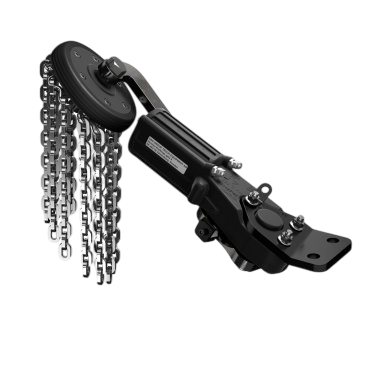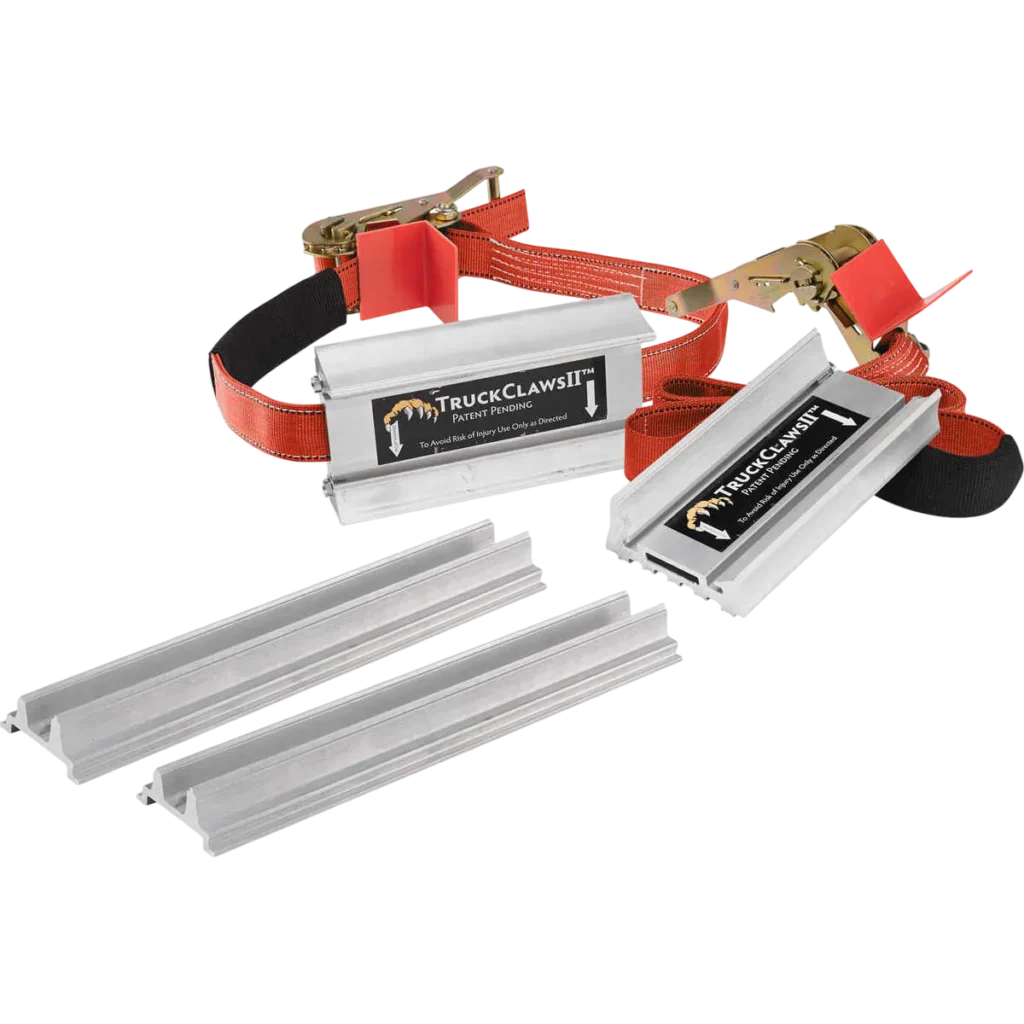Driving a commercial truck, emergency vehicle, or off-road truck in snow, ice, or mud can be tough. Losing traction on slippery roads can lead to delays, accidents, and costly downtime.
To stay safe and keep moving, truckers and fleet managers rely on traction aids.
Two popular options are Onspot Automatic Tire Chains and TruckClaws Portable Traction Aids. Onspot chains offer a built-in, automatic system for extra grip on icy roads.
On the other hand, TruckClaws provide a portable, easy-to-use solution that works in snow, mud, sand, and ice.
So, which one is better? In this comparison, we’ll look at how they work, their pros and cons, and which one is the best choice for truckers, fleets, and off-road drivers.

Onspot Automatic Tire Chains are a built-in traction system designed for commercial trucks, semi-trucks, and emergency vehicles.
These automatic snow chains are permanently installed under the vehicle and deploy at the push of a button.
When activated, a set of small rotating chains swing under the tires, creating instant traction on icy and snowy roads.
This system is commonly used by ambulances, fire trucks, police vehicles, and fleet trucks that operate in harsh winter conditions and need quick, hands-free traction control.

TruckClaws are a portable emergency traction aid that attaches manually to the drive tires of commercial trucks, off-road vehicles, and fleet trucks.
Unlike automatic tire chains, TruckClaws are an effective alternative that can be used in various emergency situations, including deep mud recovery solutions for trucks.
To use TruckClaws, the driver straps the traction plates onto the tires, which then dig into snow, ice, mud, or sand, providing immediate grip.
This makes them a versatile alternative for truckers who need a reliable traction device that works in multiple terrains.
Both Onspot chains and TruckClaws help drivers maintain traction in tough conditions, but they work in very different ways.
When choosing between Onspot Chains and TruckClaws, truckers and fleet managers need to consider factors like installation, deployment, cost, and best use cases. Here’s a direct comparison:
| Feature | Onspot Chains | TruckClaws |
| Installation | Permanently mounted under the vehicle | Manually strapped onto tires in minutes |
| Deployment | Automatic, button-activated | Requires manual attachment |
| Weight & Storage | Heavy and installed full-time | Lightweight and portable |
| Best Use Case | Highway snow and ice (fleets & emergency vehicles) | All-terrain traction (snow, mud, sand, ice) |
| Cost | Expensive (requires professional installation) | Affordable (no professional installation needed) |
| Durability | Long-lasting but requires regular maintenance | Durable and reusable in multiple conditions |
From this comparison, Onspot Chains are best for fleets and emergency vehicles that need quick, automatic traction in snowy conditions, while TruckClaws are ideal for truckers, off-roaders, and fleet operators who need a versatile, portable traction aid for various terrains.

When it comes to real-world performance, both Onspot Chains and TruckClaws help truckers maintain traction in difficult conditions. However, their effectiveness varies based on the terrain and how they are used.
In short, Onspot Chains are great for maintaining traction on highways, while TruckClaws are better for getting unstuck in deep snow or icy patches.
If you often drive through muddy roads, construction sites, or off-road trails, TruckClaws offer better versatility and performance than Onspot Chains.
For situations where a truck needs fast, on-the-spot recovery, TruckClaws are the superior option.
When choosing between Onspot Chains and TruckClaws, cost is a major factor. Let’s break it down:
For businesses managing multiple trucks, the savings with TruckClaws can be significant, making them the better long-term investment for emergency traction needs.

When comparing Onspot Chains and TruckClaws, ease of installation and deployment is crucial, especially in emergency situations.
While Onspot Chains offer convenience for fleet and emergency vehicles that frequently drive in snow, they lack the flexibility needed for off-road or recovery situations.
Understanding the right traction devices for winter driving can help drivers make the best choice for their needs.
Compared to Onspot Chains, TruckClaws offer more flexibility and control. Drivers don’t need to rely on pre-installed systems—they can use TruckClaws whenever needed, whether they’re driving on highways or tackling rough off-road conditions.

While traction devices like Onspot Chains and TruckClaws provide excellent grip in snow and mud, some regions have specific tire chain laws and traction device regulations that drivers must follow.
When choosing between Onspot Chains and TruckClaws, it’s important to consider Department of Transportation (DOT) snow chain laws and other regulations that apply to commercial trucks.
Since regulations vary by region, truckers and fleet managers should check local DOT requirements to ensure compliance.
Different drivers have different needs when it comes to traction solutions. Here’s how TruckClaws and Onspot Chains compare for specific users:
TruckClaws are the better all-around choice for most truckers, fleets, and off-road drivers. Onspot Chains work well for consistent highway snow conditions, but they lack versatility.
When dealing with slippery conditions, drivers must carefully manage acceleration and braking to maintain control. Learning how to drive in slippery mud safely can prevent accidents and vehicle damage.
Choosing between Onspot Chains and TruckClaws depends on your specific needs. Here’s a quick guide to help you decide:
While Onspot Chains are convenient for highway fleets in snowy regions, they are expensive, limited to specific conditions, and require professional installation.
In contrast, TruckClaws offer affordable, on-demand traction for various terrains, making them the better choice for independent truckers, fleet managers, off-roaders, and emergency responders.
Not necessarily—Onspot Chains work well for highway use in snowy conditions, but TruckClaws offer more versatility by working in snow, ice, mud, and sand.
They are also portable and cost-effective, making them the better choice for emergency recovery and off-road driving.
Yes! TruckClaws provide instant traction in deep snow, packed ice, mud, and even sand. They are designed to help vehicles escape stuck situations quickly, unlike Onspot chains, which only help with traction while driving.
Automatic chains like Onspot are worth it only if your fleet operates in consistent highway snow conditions and requires a hands-free solution.
However, if you need a cost-effective, multi-terrain traction aid, TruckClaws provide a much better return on investment.
When it comes to reliable traction in all conditions, TruckClaws stand out as the smarter, more versatile solution.
Unlike Onspot Chains, which are limited to highway snow and ice, TruckClaws provide instant traction in snow, ice, mud, and sand—making them the best choice for truckers, fleet managers, off-roaders, and emergency recovery situations.
With easy installation, portability, and reusability, TruckClaws offer a cost-effective alternative to expensive, permanently installed automatic chains.
If you need a dependable emergency traction aid without the hassle of professional installation and maintenance, TruckClaws is the way to go!
